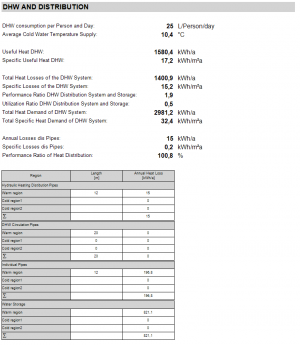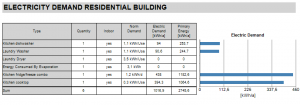Passive:Verification: Unterschied zwischen den Versionen
SebSta (Diskussion | Beiträge) |
SebSta (Diskussion | Beiträge) |
||
| Zeile 35: | Zeile 35: | ||
== Climate == | == Climate == | ||
[[Bild:Passive-verification_climate.png|right|thumb|Climate]] | [[Bild:Passive-verification_climate.png|right|thumb|Climate]] | ||
Here you find a graphical overview of the climate given in the [[Passive2:Dialog_Climate|localization/elimate]] section and possible calulations of undefined values (e.g. ground/sky temperatures).<br> | Here you find local climate conditions e.g. the height of the building or ground conditions.<br> | ||
Furthermore there is a graphical overview of the climate given in the [[Passive2:Dialog_Climate|localization/elimate]] section and possible calulations of undefined values (e.g. ground/sky temperatures).<br> | |||
The second graph displays the solar radiation sepatated by their orientation.<br style="clear:both" /> | The second graph displays the solar radiation sepatated by their orientation.<br style="clear:both" /> | ||
Version vom 24. Juli 2013, 14:20 Uhr
Results of Passive House Verification
This page shows the different subpoints of the output of the Passive House Verification. There will be a short description of the output parameters for each subpoint as well as a screenshot.
Building Information
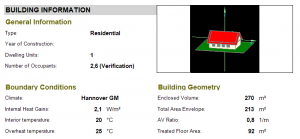
The first section summarizes general information about the building itself and important boundary conditions such as the interior temperature or the internal loads.
Passivehouse requirements
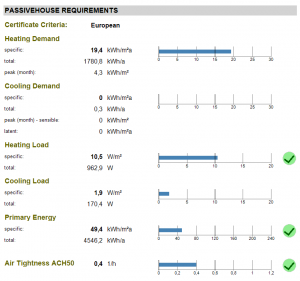
The primary passive house requirements depend mostly on energy demand, mainly in form of cooling and heating as well as primary energy demand. All values are given in a specific value (per square meter/feet) and in total. Heating and cooling demand also provide a peak value(month), which is estimated by the extreme weather conditions in the climate tab.
Secondary Passivehouse Requirements

The secondary requirements consist of the HRV efficiency and a percentage chance of overheating of the building. Depending on the values WUFI®Passive will give recommendation if a seperate cooling system is needed or not.
Building Elements
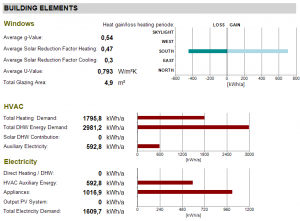
The building elements describes the influences of windows, HVAC systems and electric devices on the energy demand.
Windows
The graphic shows the heat losses and gains of solar radiation through windows depending on the orientation. Also average values for all windows are given together with the total glazing area.
HVAC
The energy demand of all HVAC devices is summarized here.
Electricity
The energy demand of all other electric devices is listed here.
Heat Flow

Heat gains and losses are divided on different causes.
Heat gains are seperated into solar gains, inner sources, thermal bridges and mechanical heating.
Heat losses are seperated into windows&doors, the building envelope and natural and mechanical ventilation.
Both statistics are displayed in a pie chart.
Climate
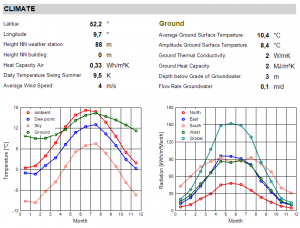
Here you find local climate conditions e.g. the height of the building or ground conditions.
Furthermore there is a graphical overview of the climate given in the localization/elimate section and possible calulations of undefined values (e.g. ground/sky temperatures).
The second graph displays the solar radiation sepatated by their orientation.
Calculation Parameters
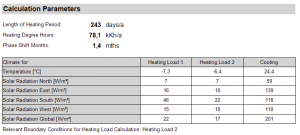
Someone else might explain this better than i do.
Annual Heat/Cooling Demand

Opposes annual heat gains and losses and thereby calculates the annual heat/cooling demand.
Heating/Cooling Load
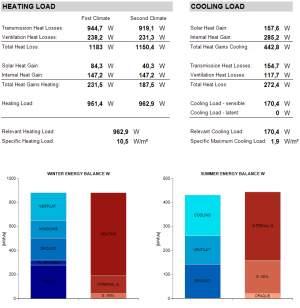
Someone else might explain this better than i do.
Areas
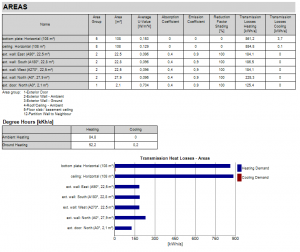
Thermal Brigdes
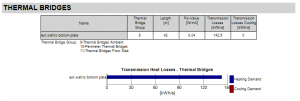
Summarizes all thermal bridges given in the thermal bridge tab of the tree and its heat gains and losses.
Windows
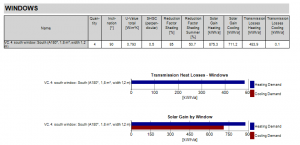
Shows the number, orientation and specific values of all windows and their influence on the heat gains and losses. These results are used in the calculation of the heating and cooling demand.
Summary Building Envelope
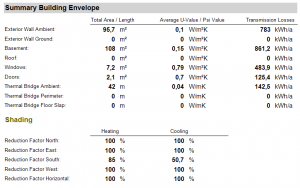
Dimensions of all building elements as well as their U- or Psi-Value. Also the transmission losses of each element, which are also needed for the heat gain/loss statistic are given.
The respective shading effect of each orientation is given here too.
HVAC Systems
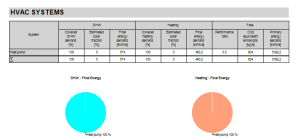
An enumeration of all HVAC systems and their influence on the DHW consumption, heat gains/losses and primary energy demand or a equivalenct CO2 emission.
Ventilation

Someone else might explain this better than i do.
Electricity Demand - Auxiliary Electricity

A table containing the energy demand of all HVAC and all affiliated systems.
Electricity Demand Of Electric Devices
A list of all input electric devices and their annual electric demand.
As input of residential and non-residential building differs, WUFI has different graphics for each type.
Internal Heat Gains

DHW and Distribution
